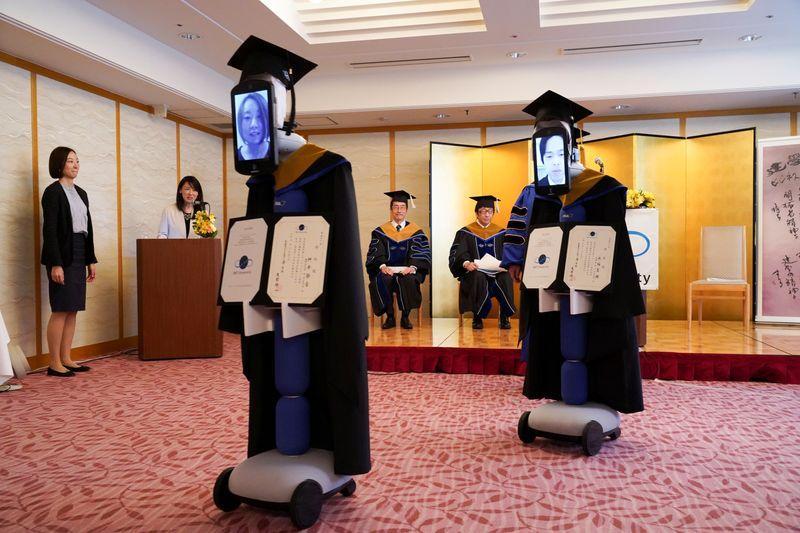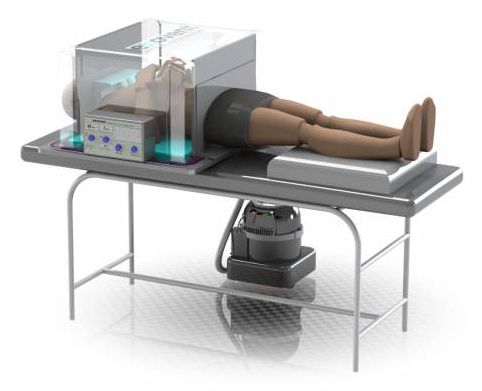Added a new photo.



Welcome to the twilight zone.
TOKYO (Reuters) — Spring graduation ceremonies in Japan have been cancelled because of the coronavirus pandemic, but students at one school were able to attend remotely by controlling avatar robots while logged on at home.
The robots, dubbed “Newme” by developer ANA Holdings, were dressed in graduation caps and gowns for the ceremony at the Business Breakthrough University in Tokyo.
The robots’ “faces” were tablets that displayed the faces of the graduates, who logged on at home and controlled the robots via their laptops.

The ruling is likely to lead to the final authorisation of their sale across the EU as a “novel food” by as soon as the autumn, opening up opportunities for mass production of a range of insect dishes to be sold across Europe for the first time.
Food safety agency’s decision could put mealworms, locusts and baby crickets on menus.

Gynandromorphy produced a bee with half of its body displaying female features, and the other half of its body showing male traits.
Rare bee has a body that’s half-male, half-female, and split exactly down the middle : Read more
“When the nest was collected, the bee was a larva enclosed in a brood cell, a chamber in the honeycomb where young bees grow,…” Megalopta, or sweat bees do not form honeycomb. These bees nest in excavations in dead wood. https://www.researchgate.net/figure/Cut-away-view-of-a-nest-…_227655294

British engineers are developing a modern version of the Negative Pressure Ventilator (NPV), more popularly known as the “iron lung,” to provide COVID-19 patients under the care of the NHS with a simple, inexpensive alternative to ventilators.
One of the resources that is in critically short supply for treating COVID-19 patients in need of respiratory support is ventilators. They help to support breathing in people whose lungs have been heavily affected by the virus, but these machines face a number of problems.
The most obvious difficulty is that ventilators are in short supply across the world as health authorities scramble to secure enough to meet the current and estimated demand as the pandemic spreads. They are also complex, expensive, require monitoring by trained personnel, and are dangerous to use on even healthy people because they require the patient to be intubated and sedated, and sometimes even paralyzed.

Is you wear a facemask please keep this in mind:
1. The Coronavirus can live on the outside of your mask for up to 7 days.
https://www.thelancet.com/journals/lanmic/article/PIIS2666&#…3/fulltext
2. Don’t touch your mask.
3. Wash your hands frequently.
Here, we report the stability of SARS-CoV-2 in different environmental conditions.



Coronavirus-stricken British Prime Minister Boris Johnson was rushed to intensive care on Monday — as cases of the disease soared past 1.3 million across the globe.
The news came as the US reached a grim milestone of its own, with the death toll topping 10,000 and the number of cases hitting 347,000.
And it may get worse, yet. New data suggests that the peak of the pandemic — when an alarming 3,130 Americans are predicted to die in a single day — is still 10 days away.
I met with an accident in 1997.I suffered a spinal cord injury in that accident.3 months go I took stem cell therapy at Neurogen. In these 3 months I feel I have improved a lot more than before. My legs feel loose. My back also feels free. While walking my legs used to crossover each other, that has now reduced. All the muscles of my legs were very tight.
before now it has reduced. Climbing up and down the stairs is also easier than earlier.
I can also move my toes know. Earlier while walking my legs used to cross over each other, now that has reduced and I can walk much better. From lying down I can get up much easily and I can do it on my own now. Earlier I used to do bed rolling as an exercise which is much easier now. I get up from bed very easily now, back seems.
less tight and I can do the movements freely. I can roll, turn and crawl in the bed freely, than before. I can now shift forward and backward in the bed easily and on my own. Earlier while standing and walking the heel of my foot used to lift off the ground, now it touches the ground. I can balance myself on both legs now. I feel I have a good grip while walking, bearing more weight on both the legs. While climbing stairs I can lift my leg up on my own and climb. I can now stand on my own without any support. Earlier both these muscles were very tight Now they have become loose helping me Walk better.
Earlier I could not do this exercise at all But now I am able to lift my back easily
Improvement
Adductor spasticity has decreased.
Earlier he had a scissoring gait. Now
he is able to walk normally.
Hip control is better.
Trunk muscles have improved, so
getting from supine position is easy.
Intrinsic foot muscles has improved.